February 2008
Monthly Archive
Monthly Archive
Posted by ben on 27 Feb 2008 | Tagged as: books, ceramics, essays, responses/reviews
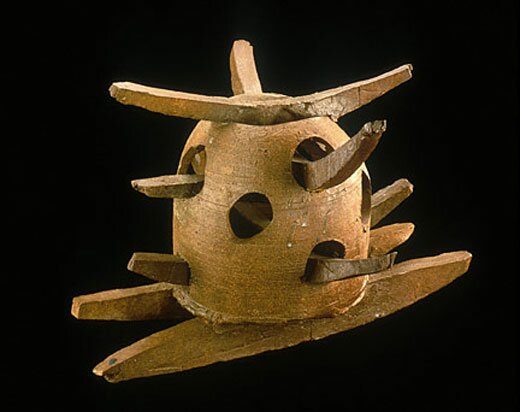
This is the first half (or so) of Garth Clark’s Subversive Majesty: Peter Voulkos’ Rocking Pot (included in , his brilliant book on ceramic art):
Rocking Pot is inarguably one of Peter Voulkos’ most inventive and important works. Its strength comes from its intense mixture of ambiguity and ambivalence. Its form is perplexing because it seems familiar; a relative of the domestic pot. Yet its self-penetration of volume and its strange base, made up of two curved feet or “rockers,” sows confusion and challenges its claim to vesselness. It presents itself simultaneously as a pot, a sculpture, and a demented birdfeeder. But Voulkos has no such confusion about the piece. Unequivocally he has stated, “I claim this as a pot.”
That, then, should be the last word on the subject. But in the world of ceramics there is a curious tendency to “upgrade” pots to sculpture when they project the energy of art, as though the pot is too lowly a medium for higher levels of expression. Obviously this is often at the hands of critics who have not spent any time with a Ming vase or a Mimbres bowl. But this elevation to sculpture is meant to be a compliment to the artist (albeit backhanded), and undoubtedly this is what Rose Slivka intended when she described Rocking Pot as “one of Voulkos’s earliest outright sculptures. The pottery technique is evident, while the pottery function is subverted to the formal invention.”
This statement perhaps best reveals the core misunderstanding among the fine arts in the (under) appreciation of the dynamism of pottery. Pots do not cease to be pots when function is subverted. Indeed, for millennia, denying function has been one of humankind’s ways of setting aside certain vessels for a different role, one that perforce became ritualistic and contemplative. Sometimes the act of removing function was profound, as in the Mimbres culture’s practice of putting a hole into the bottom of bowls of the deceased, to allow their souls to escape into the spirit world. This precluded domestic/utilitarian ideas of containment in favor metaphorical containment, in this case a purposeful permeability. In other cases function was obscured rather than denied for reasons of whimsy — to tease the user, as with the so-called puzzle jugs and mugs of the Medieval period.
What supports Voulkos’ insistence that this object be seen as a pot is that it becomes more intriguing when viewed in ceramic terms rather than from a purely sculptural viewpoint. The act of cutting holes into an abstract sculpture is primarily a formal act. Cutting holes into a pot is a violation. It upsets orderly notions of utility and culture. In pottery, volume is a sacred space. Holes deliberately placed by the potter provide entrances and exits. But when punctured in the seemingly destructive and random manner of the Rocking Pot, the vessel can no longer serve its literal purpose of containment. By further skewering the interior of his pot with his curved rockers, Voulkos adds an edge of surreal spatial violence.
Violence against the vessel, however, was not Voulkos’ goal. If the sanctity of the pot has been bruised, it is simply because it has come up against the intense energy and physicality with which the artist imbues his vessels. The holes serve many purposes in this piece. On one level they are drawings in three dimensions (much like Lucio Fontana’s paintings and sculptures from his Concetto Spaziale series). One may even view them more conservatively as pottery decorations in their most abstract form. But they are also spy-holes into the interior architecture of the vessel. They reveal the pot’s powerful inner structure, which those who admire pottery as an art already know exists, but few have seen exposed in so visceral a manner.
Posted by justin on 24 Feb 2008 | Tagged as: adventure day, art paparazzi, mustaches, party photos, performance art, possibilities, rumors, silliness, sneak peeks, vs.
Posted by ben on 22 Feb 2008 | Tagged as: performance art, video/film, vs.
Bruce Nauman, Walking in an Exagerated Manner around the Perimeter of a Square (1967-68)
Monty Python, The Ministry of Silly Walks (1970)
Posted by ben on 22 Feb 2008 | Tagged as: image & sound
I’m going to start spending some time here discussing the mutual influence between music and visual art. Despite the supposed openness of the visual art world, these connections are still overlooked by too many of us. I plan to flesh out this intersection quite a bit in the coming weeks.
In 1952 John Cage composed a controversial work that has now become canonical, although it still arouses a great deal of suspicion among those who are inclined to think that starting in the second half of the 20th century, art became one big put-on. This piece, titled 4′33″, consists of four minutes and thirty three seconds of silence (here’s a ). Unfortunately, many people associate John Cage so closely with 4′33″ that they don’t know of any of his other compositions. I think some of these people might be inclined to take it more seriously if they were aware that this piece is part of a long career of very sincere exploration. In many ways, this composition is much more accessible than a lot of more “appealing” art, in the sense that it doesn’t hide anything — the idea of the composition is right there on the surface.
But there is a bit of history to the work that belies its apparent simplicity. The idea came about as a result of Cage’s Zen Buddhist practice (he was an original board member of the Zen Mountain Monastery near Woodstock, New York). Cage’s first public discussion of the work comes in his 1948 book “A Composer’s Confessions”, where he says that he would like to “compose a piece of uninterrupted silence and sell it to the Muzak Co. It will be 4 [and a half] minutes long — these being the standard lengths of ‘canned’ music, and its title will be ‘Silent Prayer’. It will open with a single idea which I will attempt to make as seductive as the color and shape or fragrance of a flower. The ending will approach imperceptibly.” But it wasn’t until four years later that he actually realized 4′33″. What happened in those four years?
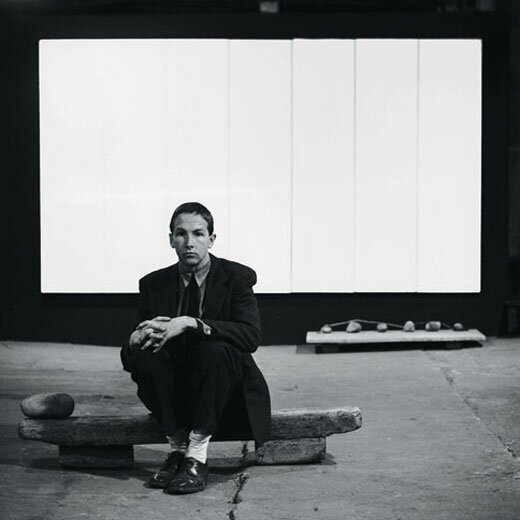
Robert Rauschenberg sits in front of his “White Paintings”
According to Cage, it was seeing Robert Rauschenberg’s “White Paintings” that finally convinced him he had to move forward with 4′33″. These paintings consist of a uniform layer of white paint on canvases. In the words of Cage, these paintings “were airports for shadows and for dust, but you could also say that they were mirrors of the air.” Similarly, Cage’s 4′33″ is an airport for sound; a hub of perception. He realized that the space of a gallery, or a performance hall, is a cathedral for perception. Why not use this space to create an opening for heightened perception of life, of the present moment in general? Rauschenberg and Cage turn the compartmentalization of these art spaces against themselves by making the invisible background noise of life the focus of our attention.
Posted by ben on 18 Feb 2008 | Tagged as: announcements, borders, politics, responses/reviews
Some of you may have been a bit surprised to see Emvergeoning turn into a platform for a political campaign yesterday (I must admit I was a bit surprised myself, despite my own flirtations with political themes). Yes, the contemporary art community in San Antonio seems to be coalescing around Obama’s campaign, but what does this really have to do with the artistic project, especially considering our previous criticisms of politically driven art?
Let me try to explain why this presidential campaign is relevant to Emvergeoning’s overall mission. In a nutshell: we are here to open up the dialog that exists within the San Antonio art community, to help draw new voices in, both from the local community and from distant cities. We want to bring more people into the conversation. This is, I think, exactly the kind of change that Barack Obama is offering America: to break down barriers in the dialog. No, he’s not going to instantly launch the United States into a post-racial, post-partisan social dynamic. No, he’s not going to end corruption and corporate influence in Washington. But Obama does represent our best chance to mollify the cynicism of our political discourse, and move partisan bickering a little closer to sincere and honest dialog.
As an example, look at Obama’s strategy while working to expand health care options in Illinois. As reported by health care expert Jonathan Cohn in the New Republic, Obama worked to build a coalition of health care activists, doctors, and hospitals, while holding direct talks with insurance and business lobbyists. Because he brought all interested parties on board as he crafted a health care task force, “He could not be accused of partisan aggression. But he got his way,” according to John Bouman, director of the Shriver Center on Poverty Law.
Contrast this approach to Hillary Clinton’s when she headed the Task Force on National Health Care Reform created by then-president Bill Clinton. The task force’s members and meetings were kept secret, so that by the time the plan was unveiled, the task force had already been sued for violating regulations related to government transparency. Meanwhile, a number of fellow Democrats crafted their own, competing health care plans, while conservatives and business interests lined up an intense PR campaign to kill the idea.
These episodes exemplify the approaches of the two Democratic candidates, one of whom works closely with both allies and opponents to build consensus through open dialog, and one of whom works within a tight political network to push things through. It could be argued that Hillary Clinton has learned her lesson from her health care debacle, if it weren’t for her campaign’s use of some of these same kinds of tactics in this primary season. Her insistence on seating the delegates from Florida and Michigan after agreeing with the Democratic National Committee’s decision to strip these states of delegates smacks of cynical political manipulation, and threatens to create an enormous rift within the Democratic party.
I don’t have much hope that Obama will be able to live up to all of his soaring rhetoric; but I do know that that rhetoric is supported by a strong record of good judgment and open discourse. Unfortunately, the same cannot be said of his opponent. It is for this reason that I see Obama as a candidate who is aligned with the goals of Emvergeoning, goals that I think are also central to the task of contemporary art.
Posted by justin on 17 Feb 2008 | Tagged as: adventure day, announcements, politics, possibilities
(sorry about the political intrusion, folks)
Local artists Cruz Ortiz, Bunnyphonic, Joe De La Cruz and myself spent 3 or 4 hours earlier tonight screening our own Obama campaign signs. We made one for every voter’s personality. Apparently nobody thought Texas was going to be very important in the whole scheme of things, so very few campaign signs have made it down our way yet. Cruz thought it better that we represent in grassroots style for the TV cameras coming through town when he speaks. If you would like one of these, there are more than 70 from tonight alone and plans for more in the next few weeks. Call to get one or to volunteer time or ideas for more. These are 2-sided, hand-screened and can come with a stake.
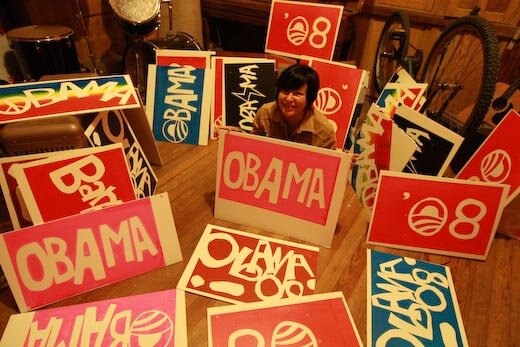
Posted by justin on 14 Feb 2008 | Tagged as: adventure day
This last weekend, I got the opportunity to shoot some photos of Bill FitzGibbons‘ recent work Katonah Lights at the Katonah Museum of Art in Katonah, New York. (Can I say Katonah again?) Creighton Michael & Leslie Cecil were amazing hosts for the weekend, and I can’t say enough nice things about the show (Shattering Glass: New Perspectives). I’m a longtime fan of innovative glass art after having taken a short study in borosilicate lampworking a few years back. The show did a good job of melding together increasingly versatile genres and styles of glasswork, from poured crystal rope to offhand glass jellyfish charged with neon and incorporating pyrex tubing. Bill’s Katonah Lights, made up of glass L.E.D.’s pulsing to an elaborate 8 minute program, became really great ever-changing eye candy for the steady stream of traffic going down Route 22 in Katonah.
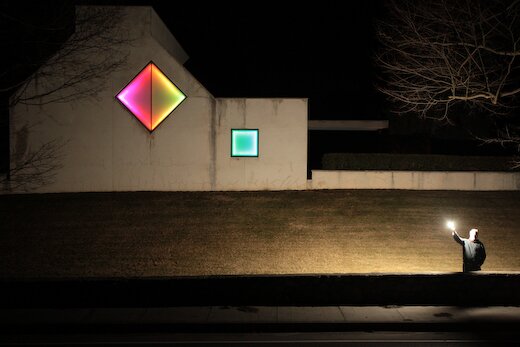
(thats Bill in the photo above)
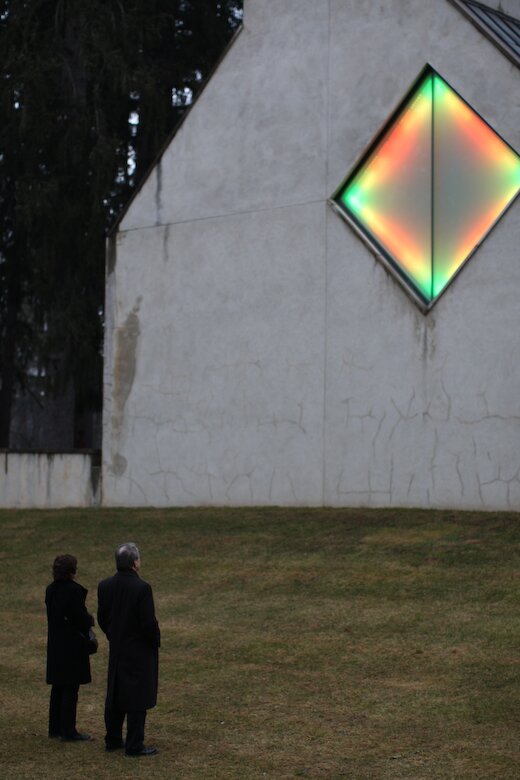
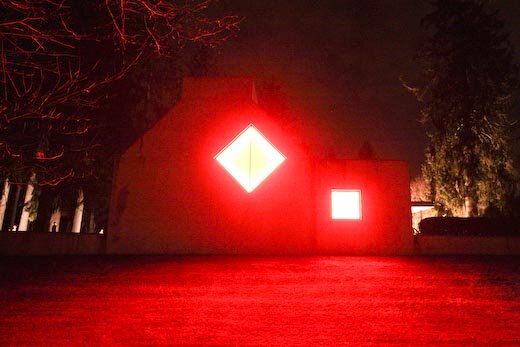
Katonah Lights will be on view @ the Katonah Museum of Art until Feb 24, 2008.
Posted by ben on 13 Feb 2008 | Tagged as: books, borders, vs.

The New York Earth Room by Walter de Maria
Cities & The Dead
What makes Argia different from other cities is that it has earth instead of air. The streets are completely filled with dirt, clay packs the rooms to the ceiling, on every stair another stairway is set in negative, over the roofs of the houses hang layers of rocky terrain like skies with clouds. We do not know if the inhabitants can move about the city, widening the worm tunnels and the crevices where roots twist: the dampness destroys people’s bodies, and they have scant strength; everyone is better off remaining still, prone; anyway, it is dark.
From up here, nothing of Argia can be seen; some say “It’s down below there,” and we can only believe them. The place is deserted. At night, putting your ear to the ground, you can sometimes hear a door slam.
— Italo Calvino, (trans. William Weaver)
Posted by ben on 12 Feb 2008 | Tagged as: design
Ever since I got a subscription to the now-defunct Emigre magazine, I’ve been interested in how obsessed a lot graphic designers are with ethics. On one level it makes sense, with graphic design being, along with architecture, one of the art few forms that ordinary people have to deal with on a daily basis. On another level it always seemed strange, since ethical considerations don’t seem to factor into the calculations of most of the designers’ clients. But perhaps this is why many designers feel compelled to grapple with morality: there’s a lot of pressure from their clients not to think about it. At any rate, there’s a new article at Design Observer does a good job of exploring the ethical implications of the Enron logo, one of the last logos created by uber-designer Paul Rand. The point that branding empowers consumers (as made in this Economist article) is an important one that is too often overlooked.
PS What is up with this new Hyatt Place logo? Does anyone find this compelling?

PPS Check out Brand New, a blog on corporate identity for more discussion of logos and branding.
Posted by ben on 11 Feb 2008 | Tagged as: music, performance art, silliness, sound art
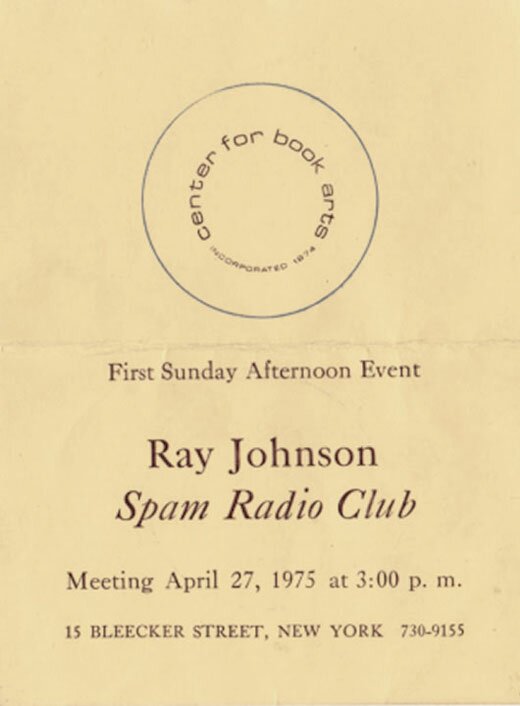
That’s still another thing about the Correspondence School, it’s not just the letters, the postcards, the drawings, the poems, it’s also the New York Correspondence School objects. The Spam radio, for example, was a radio in the shape of a Spam can, which had a little handle on it, it was a thing the Spam Corporation made one year as an advertising gimmick. It was something they gave to people, and you could go to the beach with your Spam radio, and play your radio on the beach, it was a little radio inside of a Spam can, and I didn’t really treasure it very much so I gave it to Jim Bohn.
…
But to get back to that radio, I gave it to Jim Bohn — which is BOHN and not BONE — and the following week he was in Soho walking around with his wife and carrying the Spam radio as a kind of prize trophy. He was taking it out for a walk, and the minute I saw him with it I realized that he had given it some kind of notoriety and importance, and I was intensely jealous that he was walking around with the Spam radio and that I hadn’t thought of walking around with a Spam radio, like the time I had once walked around with the head of Candy Darling in a plastic bag. So still another week later, I was in Soho again and went to the supermarket and bought a real can of Spam and put a little handle on it, and then I was walking around with that.
Posted by ben on 06 Feb 2008 | Tagged as: announcements, arts organizations, politics

The Spiral Jetty oil drilling story (broken by MAN) is picking up steam, with a little mention in the NYT, and a couple of hot-out-of-the-oven press releases. The Dia Foundation “adamantly opposes” the drilling, which it says would take place within 5 miles of Smithson’s iconic land art masterpiece. The National Trust for Historic preservation has also entered the fray. I can’t find a link to a press release from them, but the Trust’s president Richard Moe is quoted as saying “The National Trust for Historic Preservation believes that Robert Smithson’s Spiral Jetty on the Great Salt Lake is a significant cultural site from the recent past, merging art, the environment, and the landscape. We are deeply concerned about the potential harm that energy development could bring to the Spiral Jetty.”
Interestingly, the Spiral Jetty was originally situated “a few hundred yards” from another industrial jetty, which was used for oil exploration for 60 years, and was actively being used for at least 10 years after Smithson built the piece. As Tyler Green noted in a piece on the Jetty from 2005:
A few hundred yards east of Smithson’s spiral is an old industrial jetty, used for oil exploration from the 1920’s to the 1980’s. It is rotting toward dissolution. While he didn’t write about it, Smithson saw it when he was building Spiral Jetty. He must have known that the oil jetty would eventually decay and disappear, while his artwork would survive, forming a partnership with nature. It will last.
So I have to wonder how detrimental this drilling really is to the Spiral Jetty Experience, considering oil exploration was happening within a few hundred yards of the piece for 10 years or more after its creation (Smithson completed the Spiral Jetty in 1970). Maybe this new drilling operation would be more invasive somehow, or maybe I’m misunderstanding the role of the older jetty. But if Smithson picked a location where he knew oil exploration was ongoing, maybe it doesn’t really impact the work in a negative way. Did any of our readers visit the Spiral Jetty in the ’70s or ’80s while this oil exploration was active?
On the other hand, I’m inclined to trust the Dia Foundation to understand the intended presentation of the Spiral Jetty about as well as anyone. And the fact that they only put out their press release today suggests that they spent some time considering the issues before reacting. Anyway, if you want to weight in officially, Dia has put together a form letter to express opposition to the project, along with relevant contact info.
There’s more: I just caught wind of this article in the Salt Lake Tribune, which fleshes out some of the legal and ecological issues surrounding the proposed drilling. Near the end, the author of the piece states that “the state must honor mineral rights.” It sounds like the company already has a lease on the land, which was exempted from a conservation agreement between the state of Utah and several conservation groups.
Posted by ben on 04 Feb 2008 | Tagged as: graffiti
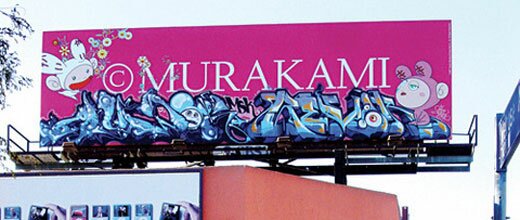
An interesting story out of LA, a bit like this tale from San Antonio, but with a happy ending:
Luckily, REVOK carried his camera that day, and L.A. Weekly received the photo; we were wowed. So, it turns out, was Murakami, whose Kaikai Kiki studio found the evidence via the Internet and had the billboard surreptitiously removed. Murakami buffing billboards all the way from Japan? On the contrary, according to his representatives, he found it “so wonderful, he had to have it for his collection.” Our billboard is now on its way to Tokyo.
(Hat tip: MAN)